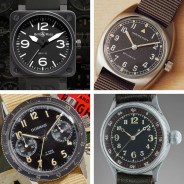IWC Pilot’s Watch Automatic Spitfire, $4,250
IWC Pilot’s Watch Automatic Spitfire, (Pre-owned)
Skip the heavy lifting and go straight to what’s best. Just Get This is our no-nonsense guide to the gear you need, now.
“Pilot’s” watches constitute a category that’s more difficult to pin down than, say, dress watches, which are generally uniformly thin, unadorned, and simple. A pilot’s watch could be a time-only watch, or it could be a chronograph. It could be relatively small, or the size of a dinner plate. It could feature a black dial, or, in some cases, a white dial. Really, the only universal thing about pilot’s watches is that — originally, anyway — they weren’t available in precious metals. Such a watch would sort of be missing the point of a true instrument.
If we had to try and delineate what’s truly important in a pilot’s watch, we’d probably say legibility — after all, if you can’t see the damn thing while flying a plane, there ain’t much point in wearing one. Because though a pilot might not need to rely upon a watch anymore in most cockpits, which are stuffed full of modern electronic gauges and displays, these watches were originally essential tools that allowed the person flying the plane to calculate distance, airspeed, flight time and more. Some pilots still use them in this way.
The Mark XI is a premier example of such legibility. Released in 1948, it was manufactured by both IWC and Jaeger-LeCoultre and issued to RAF and RAAF pilots. The IWC version, which was quickly outfitted with a shock-resistant variant of the workhorse Cal. 89 movement, eventually won out against the JLC, which was discontinued in 1953. With its black dial, white Arabic indices, iconic triangle at 12 o’clock, easily discernible white minute track and thick, highly visible handset, there was no mistaking the time on a Mark XI.
IWC’s current Pilot’s Watch collection largely draws on the Mark XI, but watches like the modern Mark XVIII and Automatic Spitfire offer the closest experience to the original. Both use classic sword hands in place of the Mark XI’s distinctive hand set (with that stubby hour hand) and add a date complication for the modern user, but there’s no mistaking the military lineage. The Automatic Spitfire has a subtly more modern dial design and costs a tad more than the Mark XVIII, but we prefer it for the value it offers with its in-house automatic movement.




